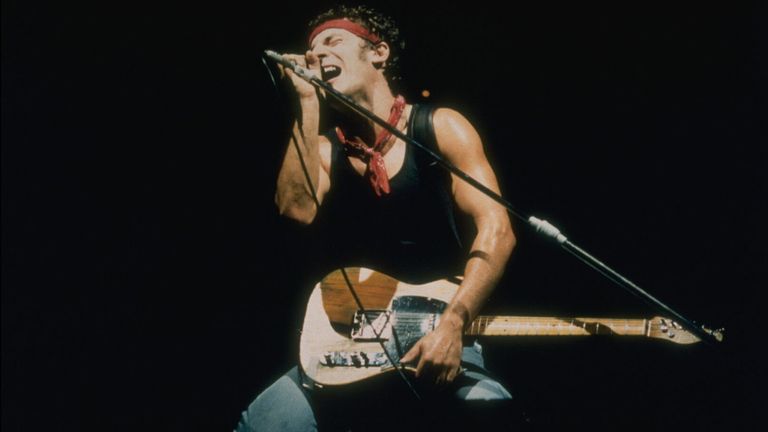Every Bruce Springsteen Album, Ranked
Bruce Springsteen was one of the many singer-songwriters hyped as “the new Dylan” in the 1970s, and he reclaimed the simple thrills of ‘50s rock and roll with an unabashed Elvis Presley swagger. But over the last five decades, Springsteen has become a paradigm in his own right, a living embodiment of how good a rock star can be at his job.
With epic four-hour concerts, patiently crafted albums, and the rousing signature sound of the E Street Band, Springsteen is both a man and a myth, New Jersey’s homegrown superhero. But he’s also been a political folk singer on The Ghost of Tom Joad, an MTV-ready pop star on Born in the U.S.A., and a movie soundtrack balladeer on hits like “Streets of Philadelphia,” sometimes stumbling but never entirely losing his way.
The Boss is a survivor — the ‘70s rock legend who most reliably tops charts and fills arenas in the 21st century. But beneath the iconic denim-clad image and the immediately identifiable growl of his voice, Springsteen is an endlessly ambitious songwriter and an unparalleled bandleader. His catalog is full of durable pleasures, from the character-filled early albums to the social commentary of Darkness on the Edge of Town to late-period triumphs like The Rising.
Excitement is already building for Springsteen’s 2023 tour, the first E Street Band trek since early 2017. And today, Springsteen is releasing his 22nd studio set, the soulful covers project Only the Strong Survive. But where does it land in our ranking of every Springsteen album?
22. Human Touch (1992)
By 1992, Springsteen had released a double album (The River), winnowed a double album worth of songs into a single album (Darkness on the Edge of Town), and divided a bounty of new songs into two albums released years apart (Nebraska and Born in the U.S.A.). The success of Guns N’ Roses’ Use Your Illusion I and II, two blockbusters released the same day in 1991, likely emboldened the Boss to try a similar simultaneous rollout for his first two records in five years. Human Touch is the longer and more labored of the pair, featuring subdued pleasures like the jazzy ballad “With Every Wish.” But it also includes one of the goofiest songs he ever released as a single, “57 Channels (And Nothin’ On).” And the highlight is the most overt ‘70s Springsteen throwback, “Roll of the Dice,” written with the only remaining holdover from the classic E Street Band lineup, pianist Roy Bittan. The Chicago Reader’s Bill Wyman wrote that “Human Touch is about the worst piece of sh** you can imagine coming from a talent on Springsteen’s level.”
21. We Shall Overcome: The Seeger Sessions (2006)
We Shall Overcome is an example of Springsteen leaning into what people expected him to be. When he was asked to contribute to the 1998 compilation Where Have All the Flowers Gone: The Songs of Pete Seeger, he didn’t know a lot about Seeger and the folk music canon, despite the leanings of albums like The Ghost of Tom Joad. Covering “We Shall Overcome” sparked Springsteen’s curiosity, and eight years later, he recorded an album of folk standards popularized by Seeger. The Grammy-winning We Shall Overcome is full of lush arrangements and spirited performances that helped bolster Springsteen’s rep as a caretaker of American musical traditions, but it’s hardly an essential piece of his catalog.
20. High Hopes (2014)
Rage Against The Machine reinvented Springsteen’s acoustic song “Ghost of Tom Joad” as a fiery uptempo rocker in 1997, a decade before it became commonplace for alt-rock bands to claim him as an influence. That cover was the beginning of Springsteen’s friendship with Rage guitarist Tom Morello, who eventually became an unlikely honorary member of the E Street Band in 2014 when Steven Van Zandt had to film a new season of Lillehammer. Morello’s innovative turntable-mimicking guitars on “High Hopes” and heavy metal shredding on “Harry’s Skin” give this album a sound unlike any other Springsteen record. But as much as you want to applaud both Springsteen and Morello for attempting such an unlikely musical marriage, it doesn’t entirely work. High Hopes, a weird hodgepodge of old and new material of disparate origins, never quite coheres. They reworked “Ghost of Tom Joad,” with Springsteen and Morello trading verses, but it lacks the roar of the Rage cover and the dusky intimacy of the original. The long-awaited studio version of “American Skin (41 Shots)” has cheesy vocal effects that break the song’s spell. But Springsteen’s love of ‘70s synth-punk duo Suicide has long bolstered his underground cred, and he finally committed his cover of “Dream Baby Dream” to wax as an excellent closer.
19. Wrecking Ball (2012)
In the aftermath of the 2009 recession, Springsteen returned to one of his familiar roles: a liberal champion of the American working class. Wrecking Ball’s tales of economic hardship and perseverance lean a little harder on stadium-ready uplift, especially lead single “We Take Care of Our Own,” which felt custom-made for President Obama’s re-election campaign. The album, released less than a year after the death of Clarence Clemons, features a couple of the Big Man’s final performances. Unfortunately, Wrecking Ball also includes the long-awaited studio recording of “Land of Hope and Dreams,” a latter-day classic that the E Street Band had been playing live since 1999 — heard here with a different drum arrangement that flattened the song’s grandeur.
